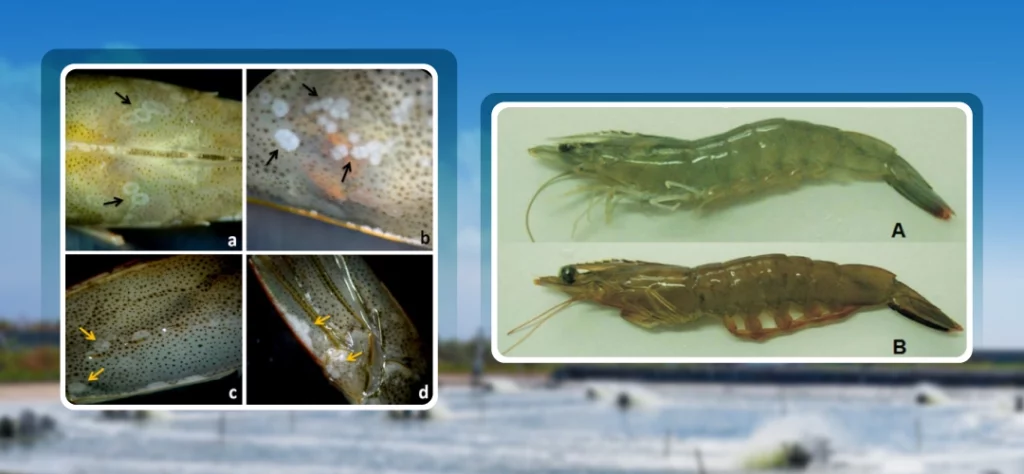Shrimp have natural properties to be at the bottom of the pond or water column. So, the shrimp will not be naturally on the surface of the water. There must be a reason why your shrimp moves and swims to the surface of the water.
Causes and How to Handle Shrimp Rising to the Surface of the Pond
If you find shrimp in the pond rising to the surface of the water, you need to be vigilant because this can be one of the symptoms of poor water quality and disease in shrimp. If that's the case, you must immediately know how to deal with floating vannamei shrimp in ponds.
Here are some reasons why shrimp rise to the surface:
1. Udang Kekurangan Pakan/Underfeeding
Underfeeding is a condition in which the feeding is too little, so that the food needs of the shrimp are not fulfilled. This will cause slow shrimp growth, weak shrimp, and a higher risk of cannibalism. One of the behaviors encountered when it occurs underfeeding is the shrimp rises to the surface to look for food with its legs moving actively.
All you have to do is take pelleted feed and spread it at the location/point where the shrimp rises to the surface. If the shrimp take the feed and fall back to the bottom of the pond, it can be ascertained that the shrimp suffer underfeeding.
Apart from that, you can also check the condition of the shrimp intestines. When the feed is finished, the shrimp will consume the detritus in the pond so that the intestines tend to be black in color. However, shrimp intestines that are empty and pale in color can be an indicator of shrimp disease and lack of feed.
To overcome this, you can increase the amount of feed by 10% the next hour. The addition of feed can be continued in stages until the feed in the anco is used up and the color of the black feces is getting less, only 20%.
2. Oksigen Terlarut (Diluted Oxygen/DO) Rendah
Dissolved oxygen/DO is a very crucial parameter because this factor affects the growth, appetite, and metabolism of farmed animals as well as the survival of microorganisms in the waters. One of the behaviors of shrimp that is encountered when dissolved oxygen is low in the waters is shrimp rising to the surface and swimming with their walking legs bent backwards.
How to measure DO or dissolved oxygen levels is to use a DO meter. If DO is less than 4 ppm, it means that the dissolved oxygen in your pond water is very low. This is caused by:
- Lack of aeration. The actions that must be taken are optimizing the existing wheels, increasing the number of wheels or aerators, and providing agricultural lime (CaCO3) or quicklime (CaO) to bind carbon dioxide in the water.
- Too much feed input causes accumulation of organic matter at the bottom of the pond. You need to do siphoning to clean the silt and sediment that is at the bottom of the pond.
- Stocking density too high. You can do partial harvesting to reduce pond stocking density.
- Increased activity of microorganisms with total bacteria exceeding 10^6 CFU/ml. You can treat this condition by stopping the addition of probiotics and nitrifying bacteria.
3. Udang Terinfeksi Penyakit

Another reason for shrimp to rise to the surface of the pond is that the shrimp are infected with disease. One of the diseases with these symptoms is WSSV or White Spot Syndrome Virus. Shrimp infected with WSSV show the following symptoms:
- Looks dying
- Shrimp floating/swimming on the surface of the water
- Tend to be at the edge of the pool
- There are white spots in the form of circles
- Appears reddish color all over his body
- Loss of appetite
- Enlarged hepatopancreas
WSSV is caused by a microscopic virus, so you need to immediately do a laboratory check to confirm and take control measures. In addition to WSSV, shrimp swimming near the surface can be caused by shrimp being infected by Protozoa.
This protozoa attaches to the gills of the shrimp, making it difficult for the shrimp to breathe. This is what triggers the shrimp to rise to the surface to be able to get oxygen.
Want to know more about the science of shrimp farming? Visit eFarm Now!
Need Help Regarding Shrimp Cultivation Business?
Fill in your personal data in the following form. Our team will immediately contact you via the number cellphone attached. Make sure the data entered is correct.
